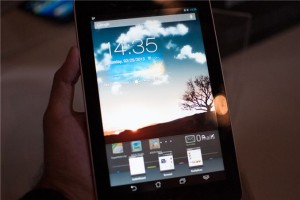By Anca Gagiuc on March 15, 2013 in Technology
 Is it a tablet, is it a phone? Why not two in one?
Is it a tablet, is it a phone? Why not two in one?
Asus keeps coming up with very interesting technology and based on their latest release, one could say that they’re having a good time experimenting with the industry’s most popular mobile devices: the smartphone and the tablet.
At the Mobile World Congress they revealed the pair Fonepad and Padfone Infinity. The first one is a 7-inch Android tablet with a 1280×800 display. It runs on Android 4.1.2 OS with 16GB of storage and 1GB RAM. A microSD slot for expanded file storage is available. What makes this tablet interesting is the micro SIM for voice calls. Although highly commented upon, with clear emphasis on its futility (who would want to hold a “phone” that has the microphone too far from the earpiece because of its size that resembles a book?), it’s still a nice experiment result. Still, headsets were created with a purpose, weren’t they?
The 3MP rear camera is available only for Asian models; those built for Europe don’t have it. The US market most likely won’t make room for it and that’s because it lacks LTE; Asus has only 3G support.
Another interesting aspect of the Fonepad is that it’s got Intel inside, more precisely PowerVR SGX 540 GPU paired with a single-core 1.2 GHz Atom. This is quite the involution as far as the strength of the device is concerned (compared to the quad-core Nvidia Tegra 3 processor that’s in the Nexus 7), games or more elaborate applications will have it slow down fast.
As availability, Asia will welcome it in March at around $249 and Europe in April at 219 Euros.
The Padfone is not a new product line for Asus, but the updates made to the hardware bring it in line with the high-end Android competitors. The Infinity shows a 1920×1080 IPS display with Capacitive Multi touch panel; it features Android 4.2 on a 1.7GHz quad-core Qualcomm Snapdragon 600 SoC, and 2GB of RAM. 32 or 64 GB of storage complement the class-leading processor, a 13MP rear camera and a 2MP front camera, NFC, Bluetooth 4.0 with dual-band Wi-Fi and LTE support fit in a five ounce package that is 0.35-inch thick. The camera is pretty amazing, its f/2.0 five-element lens captures incredibly detailed images without a shutter lag; its dedicated image signal-processor enhances the low-light image quality and makes possible to capture up to 100 sequential photos at eight frames per second, and to record 1080p Full HD video at the same time.
Quite a powerful smartphone dressed up in a sleek unibody metallic case made of aluminum, with a 5-inch Full HD display that turns into a 10.1-inch tablet when docked into its other half, the Fonepad. It’s got brains and beauty.
The concept is a gold mine that will be deeper dug into: the Fonepad and Padfone don’t ask to be synchronized, they just do so upon docking. The Padfone’s battery life is around 19 hours of 3G talk time and can go up to 40 hours when docked into the Fonepad; the latter has the capacity to recharge the smartphone up to three times.
One downside for the 2 in 1 device is that if one breaks, both have to be replaced; another is the price tag of 999 Euros. Which of its specs would make you buy it (if/when available in the US)?


